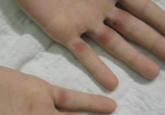Pediatric Dermatology

Subcorneal Hematomas in Excessive Video Game Play
We report a case of subcorneal hematomas caused by excessive video game play in a 19-year-old man. The hematomas occurred in a setting of...
From the Department of Pediatrics, Perelman School of Medicine at the University of Pennsylvania, Children’s Hospital of Philadelphia. Dr. Winston is from the Center for Injury and Research Prevention, and Dr. Yan is from the Section of Dermatology.
The authors report no conflict of interest.
Correspondence: Albert C. Yan, MD, Section of Dermatology, Children’s Hospital of Philadelphia, 3550 Market St, Ste 2044, Philadelphia, PA 19104 (yana@email.chop.edu).

The popularity of mobile wearable health devices has skyrocketed. Some of these devices are worn on the wrist and have been associated with the development of allergic contact dermatitis. Although nickel has been the suspected culprit in cases reported by the media for consumers, we present a rare report of a patient who developed a localized contact dermatitis that was linked to acrylate allergy on epicutaneous patch testing. We surmise that the source of this acrylate might derive from leaching of this compound from the rechargeable battery housing given its correspondence to where the rash arose.
Practice Points
Mobile health devices enable patients and clinicians to monitor the type, quantity, and quality of everyday activities and hold the promise of improving patient health and health care practices.1 In 2013, 75% of surveyed consumers in the United States owned a fitness technology product, either a dedicated fitness device, application, or portable blood pressure monitor.2 Ownership of dedicated wearable fitness devices among consumers in the United States increased from 3% in 2012 to 9% in 2013. The immense popularity of wearable fitness devices is evident in the trajectory of their reported sales, which increased from $43 million in 2009 to $854 million in 2013.2 Recognizing that “widespread adoption and use of mobile technologies is opening new and innovative ways to improve health,”3 the US Food and Drug Administration (FDA) ruled that “[technologies] that can pose a greater risk to patients will require FDA review.” One popular class of mobile technologies—activity and sleep sensors—falls outside the FDA’s regulatory guidance. To enable continuous monitoring, these sensors often are embedded into wearable devices.
Reports in the media have documented skin rashes arising in conjunction with use of one type of device,4 which may be related to nickel contact allergy, and the manufacturer has reported that the metal housing consists of surgical stainless steel that is known to contain nickel. We report a complication related to continuous use of an unregulated, commercially available, watchlike wearable sensor that was linked not to nickel but to an acrylate-containing component.
An otherwise healthy 52-year-old woman with no history of contact allergy presented with an intensely itchy eruption involving the left wrist arising 4 days after continuous use of a new watchlike wearable fitness sensor. By day 11, the eruption evolved into a well-demarcated, erythematous, scaly plaque at the location where the device’s rechargeable battery metal housing came into contact with skin (Figure 1).
Dimethylglyoxime testing of the metal housing and clips was negative, but testing of contacts within the housing was positive for nickel (Figure 2). Epicutaneous patch testing of the patient using a modified North American Contact Dermatitis Group patch test series (Table) demonstrated no reaction to nickel, instead showing a strong positive (2+) reaction at 48 and 72 hours to methyl methacrylate 2% and a positive (1+) reaction at 96 hours to ethyl acrylate 0.1% (Figure 3).

We report a case of subcorneal hematomas caused by excessive video game play in a 19-year-old man. The hematomas occurred in a setting of...
To the Editor:Prior studies have assessed the quality of text-based dermatology information on the Internet using traditional search engine...
Recently an alarming increase in the prevalence of allergic contact dermatitis (ACD) to nickel has been noted worldwide, with the majority of...
